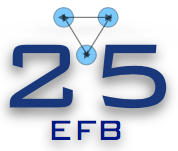Conveners
Thursday Parallel Session: Few-body systems (Atrium Maximum)
- Marc Vanderhaeghen
In this talk, I would like to discuss the theory of light muonic atoms in view of upcoming experiments, e.g., the measurement of the muonic-hydrogen ground-state hyperfine splitting with ppm accuracy. A particular focus will be on predictions of the two-photon-exchange corrections in muonic hydrogen and deuterium. Furthermore, I would like to discuss the hadronic-vacuum-polarization...
In this presentation, I will discuss the results for the $O(\alpha^5)$ effects of the nuclear structure, the two-photon-exchange (TPE) corrections, in the energies of S-levels in muonic ($\mu$D) and ordinary (D) deuterium. They were recently obtained at next-to-next-to-next-to-leading order (N3LO) in the pionless effective field theory (EFT). At this order, there is a single low-energy...
Spectroscopy in light muonic atoms provides a precision probe of the electroweak structure of light nuclei and has the potential to elucidate new physics. However, the uncertainties in the energy levels of muonic atoms are currently dominated by nuclear theory. In particular, theoretical predictions of the nuclear polarizabilities entering the two-photon exchange contribution to the energy...
Pionless effective field theory (EFT) represents a highly convenient tool to describe the nuclear interaction at low energies. This theory has been used at its leading order (LO) to study various nuclear systems, however, it has failed to give bound nuclei with A > 4 [1,2,3,4].
In our recent study [5] we adressed low-energy $p$-wave $n^3\text{H}$ scattering and the position of the $^4...
We investigate $\phi$ photoproduction on the nucleon and on the ${}^4$He targets with a dynamical model approach by considering the Pomeron exchange, meson exchange, $\phi$ radiation, and nucleon resonance excitation mechanisms. The final $\phi N$ interactions are included and described by the gluon-exchange, direct $\phi N$ couplings, and the box diagrams arising from the couplings with $\pi...
The four quark covariant equations are presented which are adjusted to the description of tetraquarks in terms of an admixture of two-body diquark-antidiquark and two meson states. These equations unify seemingly unrelated the most developed models of the tetraquark where the diquark-antidiquark and meson-meson interactions are realised via quark exchange mechanism in one of them and via...

